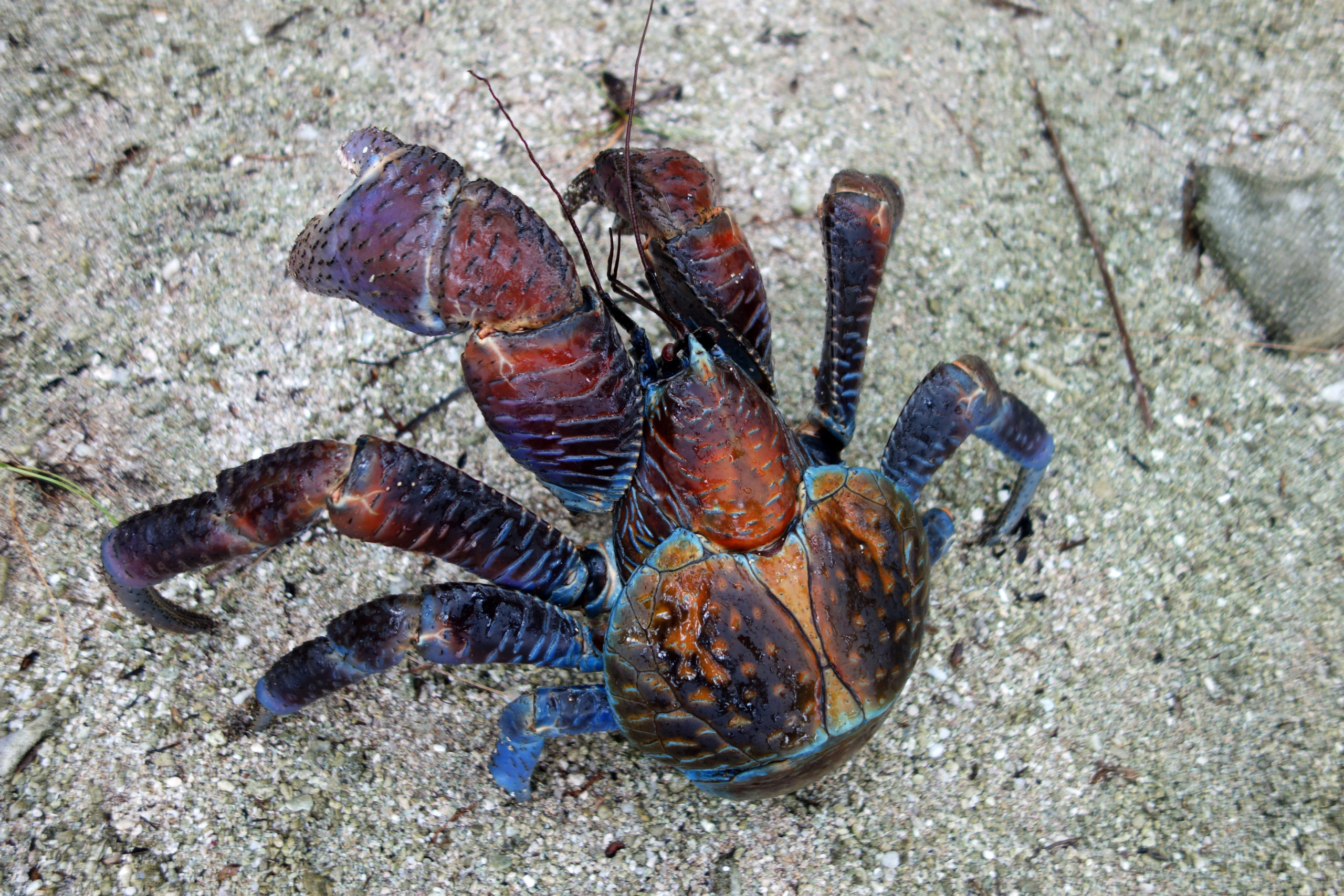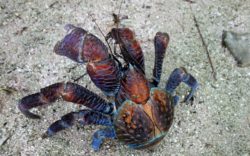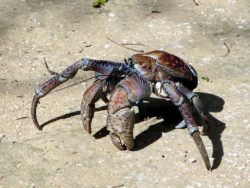
Sea Wonder: Coconut Crab
This land crab is the world’s largest and feeds on everything from coconuts to small mammals and birds – it’s the coconut crab. Thankfully, they’re named after what they eat most (coconuts) – bird-eating crab has quite a different ring to it.

Photo Credit: Wendy Cover/NOAA
Description
Coconut crabs are hermit crabs that live on land. They can grow to be three feet across, nearly one-and-a-half feet long, and weigh as much as nine pounds, making this the largest species of land crab on earth. Males are generally larger than their female counterparts, but not by much. Juveniles wear mollusk shells for protection until they reach their adult size when they can no longer fit into shells. When they outgrow their shells, they partially tuck their bellies under their bodies and rely on hardened plates on their body for protection. The only part of their bodies not covered by biological armor is the abdomen, which is covered by a thick, leathery skin that has tufts of small bristles. Females have three, large feathery appendages on their abdomens, which they use to carry egg masses.
Depending on where they live, coconut crabs can be deep blue, red, or purple-red in color, or any combination of the three. Their left claw is slightly larger than their right (which is the case for most species of crabs, a phenomenon called asymmetrical chelae), both of which are located near the front of their bodies. Their pinchers are among the strongest of all land animals, creating nearly 750 pounds of force when they close. They have two pairs of walking legs that have pointed dactyls at the end used for gripping tree bark and other tough surfaces. Interestingly, coconut crabs have gills but, as a result of evolution and thousands of years on land, they don’t work – they instead use lungs for gas exchange like we do.
Diet & Habitat
Coconut crabs live on the coastlines of marine islands throughout the tropical western Indo-Pacific Ocean in places like Madagascar, Seychelles, and Easter Island. Within the National Marine Sanctuary System, we seem them on islands adjacent to National Marine Sanctuary of American Samoa. They live in burrows which offer them protection and allow them to safely store food, and it seems they bury themselves completely during molting periods (when they shed their exoskeleton and grow a larger one to take its place). Adult crabs are primarily terrestrial but will on rare occasion make their way into the water.
Adult coconut crabs are omnivorous scavengers, which means they eat pretty much anything they can find. They eat animal carcasses, the molted skeletons of other crustaceans, tropical fruits, and coconut meat. They often use their claws to poke a hole into the soft eye of a coconut before splitting it open, but some coconut crabs will drag coconuts to the top of a tree, dropping them to break them open. They will bring larger food items back to their home burrows for safe consumption and storage for later. They eat more ahead of molting periods and will eat their own exoskeletons after shedding.
The only known predator adult coconut crabs have to worry about is humans, though juveniles may be prey for lizards, toads, and feral pigs.
Life History
Coconut crabs start their lives as planktonic larvae in the ocean. They feed on other plankton and transform through several life cycles before they reach their sub-adult stage and make their way toward land. On the way to shore or shortly after arriving, young coconut crabs will find the perfect shell to call home until they outgrow it, offering them protection from any potential predators and the elements.
Coconut crabs are generally nocturnal animals and generally live alone, venturing out of their burrows to find food or mate. On larger islands, coconut crabs are nomadic and will frequently dig new burrows for themselves. During molting periods, coconut crabs can stay buried for as long as 16 weeks! Talk about a home body.
Coconut crabs have eye stalks and what seems to be acute vision, and they sense olfactory cues (what we call smells) with antennules. Being solitary, they don’t have a great need for communication, but when they do encounter other crabs they seem to use visual cues – like vertical movements of their claws or legs – to signal to other crabs.
Mating seems to relate to lunar or tidal cycles, with females being able to breed once per summer, with a gestation period of four to six weeks. Both males and females appear to reach sexual maturity around five years old and can produce between 50,000 and 138,000 embryos per spawn! Most of these embryos, however, don’t survive into adulthood. The ones that do survive can live to be upwards of 60 years old!
Threats & Conservation
The IUCN lists the coconut crab as a data deficient species, meaning we don’t yet know enough to determine its conservation status. Knowing people are the only major predator of coconut crabs, we can assume overharvesting is a potential – though not likely – threat to the species, especially since they grow so slowly. Other dangers to coconut crabs relate to climate change, which may affect food availability and reproductive cycles, and ocean acidification, which would make life difficult for larval and juvenile crabs to grow their exoskeletons.

